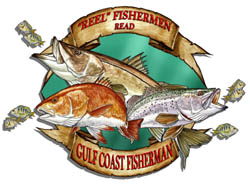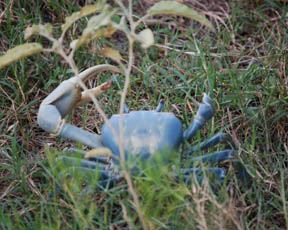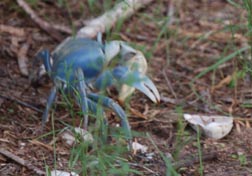
The Saltwater Magazine for Gulf Coast Fishing!
FISHING FORECASTS | FISHING CALENDARS | ARTICLES | SUBSCRIBE
Search Gulf Coast Fisherman's
Web Site
Past articles, specific
places or fish, etc.

The Land Crab...
by John Hook
Bay Naturalist
| CURRENT
MOON lunar phases |
GULF COAST
FISHERMAN T-Shirts
GCF
T's are here!
It's like a script from a bad Japanese movie...

Giant Land Crab - Cardisoma guanhumi
Hordes of clawed beasts stagger stiffly from the ocean, marching undeterred through the predawn mist toward peaceful waterfront homes. The clicking of ivory tipped claws is almost deafening, but it cannot drown the horrified scream of a housewife who has had her early morning coffee interrupted by a giant blue-backed land crab advancing across her bay front patio. As she runs screaming into her home, the single fist-sized invader raises his gleaming claw and snaps it in defiance of the pitiful human interloper.
That scenario actually happens in much of the Florida and South Texas coast, although the details are significantly less frightening and to be completely truthful, we are the invaders not them. Regardless of who gets the bad guy label, human/land crab interactions always seem to end up as unpleasant experiences for one of the parties. While mass organized invasion doesn't happen, large numbers of giant land crabs (Cardisoma guanhumi) continue to violate the yards and patios of bay front homes making property owners very unhappy. Land crabs are primarily vegetarians and they are all burrowers. Those two characteristics make them unwelcome visitors at well-manicured landscapes or coastal fruit and vegetable farms. On the other hand, people have a completely different response to land crabs when they show up on the menu. Between our anger at land crabs for property destruction and our appreciation of them as dinner, the crabs are coming out on the short end of the battle.
Land crabs don't start out on land. Crab romance takes place there, but
during the full moons of late summer and early fall egg laden females migrate
to salt  water so each crab can release their half
a million or so young before returning to land. Where crabs are abundant,
this migration causes quite a mess as they try and cross highways on the
way to the beach. In fact, our Naval base at Guantanamo posts warnings to
avoid the crabs during these times because the vultures attracted to all
the carnage on the roads causes serious problems for aircraft take off and
landings!
water so each crab can release their half
a million or so young before returning to land. Where crabs are abundant,
this migration causes quite a mess as they try and cross highways on the
way to the beach. In fact, our Naval base at Guantanamo posts warnings to
avoid the crabs during these times because the vultures attracted to all
the carnage on the roads causes serious problems for aircraft take off and
landings!
After the larval crabs spend about six weeks at sea and go through several metamorphoses, they are ready to come ashore and begin life as true land crabs. They must continue to have contact with water in order to breathe, but it doesn't need to be salt water and they can go a day or so between dunking. This allows the crabs to move inland up to 5 miles from the coast as long as the area is very low. The area must be low in order to the crabs to successfully burrow. They dig down below the water table and create a chamber that holds about a half gallon of water. In areas of low salinity this creates habitats for at least one species of small fish and a number of different varieties of mosquito (another reason to be mad at them). The crabs stay in their holes during the day and come out at night to feed, sometimes ranging up to half a mile from their burrow. At dawn they are back at the hole waiting for heat or intruders to send them scurrying down to their private pools.
On the positive side, these crabs are very tasty (See Caribbean Crab and Rice recipe). Most of the Caribbean Islands have over exploited their crabs to the point that traditional crab feasts are a thing of the past. The Bahamas have done a better job of controlling the crab harvest and to their credit the Andros Crabfest is still held every year. Our crab populations have been strong partly because most folks are unaware of land crabs and what to do with them. However, that has changed with the influx of island immigrants and as a result Florida has implemented regulations on catch methods, seasons and bag limits. Currently you are allowed up to 20 crabs per person and they can only be collected by dip net or hand. Be careful if you choose the hand option, that big claw packs quite a pinch. The season is closed from July 1st to November 1st to protect spawning migrations. Texas has not established regulations on the crabs, yet. While there are records of giant land crabs in Alabama, Mississippi and Louisiana, there are not many and those have a hard time due to low winter water temperatures.
These tropical crabs are a tough bunch that has been around a long time. If you are a victim of crab trespass and you are determined to drive them off try dropping a polished sea bean down their hole. According to Island lore it will drive them crazy. Or you could simply choose to catch them for the table. Either way, the invasion battle between people and land crabs is sure to continue.
Caribbean Crab and Rice
To serve 4-6
Once you have the crabs, purge them for 4 or 5 days by feeding them cornmeal, lettuce and vegetables. This cleans them of any undesirable material they have recently eaten. Remember to dunk them in water daily.
Ingredients
4 purged land crabs
2 cups uncooked rice
3-* cups shellfish stock, fish stock or bottled water
1 14 oz can diced tomato with chilies
1 6 oz can tomato paste
2 Tbs olive oil
2 Tbs Worcestershire sauce
2 Tbs soy sauce
2 Tbs Tony's Creole Seasoning
2 Tbs chopped garlic
2 Tbs Capers
1 Medium onion, chopped
2 Green peppers, chopped
2 ribs Celery, chopped
1 tsp Thyme, dried
Fresh ground black pepper
Directions
Drop live crabs into twice as much boiling salted water as needed to cover them, return to boil and remove from heat for 10 minutes. Rinse the crabs under cool water and clean by removing the top of the shell, gills and organs. Wash crabs with a nylon brush in salted water acidulated with vinegar. Crack the claws and body leaving the meat inside. In a large pot with a tight fitting lid, sauté the diced pepper, onion and celery in the olive oil until tender. Add the garlic for 1 minute longer. Add the crab, Tony's, thyme and pepper. Continue to sauté for 2-3 minutes and then stir in completely the stock, tomatoes, tomato paste, capers, soy and Worcestershire sauce. Add the rice and bring to a boil. Reduce heat to low, cover the pot and simmer for 20 minutes or until the moisture as been absorbed. Serve with a crisp salad, French bread and chilled white wine.

